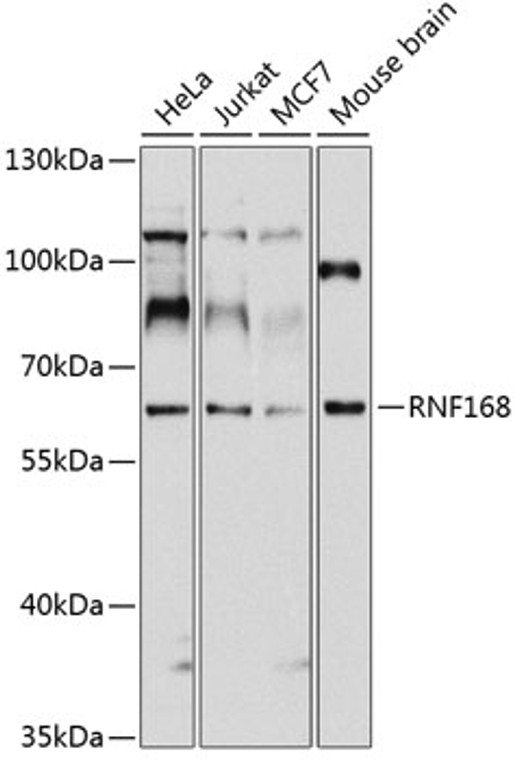| Host: |
Rabbit |
| Applications: |
WB |
| Reactivity: |
Human/Mouse |
| Note: |
STRICTLY FOR FURTHER SCIENTIFIC RESEARCH USE ONLY (RUO). MUST NOT TO BE USED IN DIAGNOSTIC OR THERAPEUTIC APPLICATIONS. |
| Short Description: |
Rabbit polyclonal antibody anti-RNF168 (300-571) is suitable for use in Western Blot research applications. |
| Clonality: |
Polyclonal |
| Conjugation: |
Unconjugated |
| Isotype: |
IgG |
| Formulation: |
PBS with 0.02% Sodium Azide, 50% Glycerol, pH7.3. |
| Purification: |
Affinity purification |
| Dilution Range: |
WB 1:1000-1:2000 |
| Storage Instruction: |
Store at-20°C for up to 1 year from the date of receipt, and avoid repeat freeze-thaw cycles. |
| Gene Symbol: |
RNF168 |
| Gene ID: |
165918 |
| Uniprot ID: |
RN168_HUMAN |
| Immunogen Region: |
300-571 |
| Immunogen: |
Recombinant fusion protein containing a sequence corresponding to amino acids 300-571 of human RNF168 (NP_689830.2). |
| Immunogen Sequence: |
WLCACGAEWYHEGNVKTRPS NHGKELCVLSHERPKTRVPY SKETAVMPCGRTESGCAPTS GVTQTNGNNTGETENEESCL LISKEISKRKNQESSFEAVK DPCFSAKRRKVSPESSPDQE ETEINFTQKLIDLEHLLFER HKQEEQDRLLALQLQKEVDK EQMVPNRQKGSPDEYHLRAT SSPPDKVLNGQRKNPKDGNF KRQTHTKHPTPERGSRDKNR QVSLKMQLKQSVNRRKMPN |
| Post Translational Modifications | Sumoylated with SUMO1 by PIAS4 in response to double-strand breaks (DSBs). Ubiquitinated. |
| Function | E3 ubiquitin-protein ligase required for accumulation of repair proteins to sites of DNA damage. Acts with UBE2N/UBC13 to amplify the RNF8-dependent histone ubiquitination. Recruited to sites of DNA damage at double-strand breaks (DSBs) by binding to ubiquitinated histone H2A and H2AX and amplifies the RNF8-dependent H2A ubiquitination, promoting the formation of 'Lys-63'-linked ubiquitin conjugates. This leads to concentrate ubiquitinated histones H2A and H2AX at DNA lesions to the threshold required for recruitment of TP53BP1 and BRCA1. Also recruited at DNA interstrand cross-links (ICLs) sites and promotes accumulation of 'Lys-63'-linked ubiquitination of histones H2A and H2AX, leading to recruitment of FAAP20/C1orf86 and Fanconi anemia (FA) complex, followed by interstrand cross-link repair. H2A ubiquitination also mediates the ATM-dependent transcriptional silencing at regions flanking DSBs in cis, a mechanism to avoid collision between transcription and repair intermediates. Also involved in class switch recombination in immune system, via its role in regulation of DSBs repair. Following DNA damage, promotes the ubiquitination and degradation of JMJD2A/KDM4A in collaboration with RNF8, leading to unmask H4K20me2 mark and promote the recruitment of TP53BP1 at DNA damage sites. Not able to initiate 'Lys-63'-linked ubiquitination in vitro.possibly due to partial occlusion of the UBE2N/UBC13-binding region. Catalyzes monoubiquitination of 'Lys-13' and 'Lys-15' of nucleosomal histone H2A (H2AK13Ub and H2AK15Ub, respectively). |
| Protein Name | E3 Ubiquitin-Protein Ligase Rnf168Hrnf168Ring Finger Protein 168Ring-Type E3 Ubiquitin Transferase Rnf168 |
| Database Links | Reactome: R-HSA-3108214Reactome: R-HSA-5693565Reactome: R-HSA-5693571Reactome: R-HSA-5693607Reactome: R-HSA-69473 |
| Cellular Localisation | NucleusLocalizes To Double-Strand Breaks (Dsbs) Sites Of Dna Damage |
| Alternative Antibody Names | Anti-E3 Ubiquitin-Protein Ligase Rnf168 antibodyAnti-Hrnf168 antibodyAnti-Ring Finger Protein 168 antibodyAnti-Ring-Type E3 Ubiquitin Transferase Rnf168 antibodyAnti-RNF168 antibody |
Information sourced from Uniprot.org
12 months for antibodies. 6 months for ELISA Kits. Please see website T&Cs for further guidance







